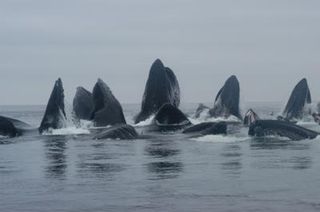Distinct Humpback Whale Populations Found in North Pacific

Five distinct humpback whale populations have been identified across the North Pacific Ocean in the most comprehensive genetic study of the mammals in this region yet, a new study reports.
The ranges of the newly identified populations include: Hawaii; Mexico; Central America; Okinawa and the Philippines; and an additional West Pacific population whose range has yet to be determined more specifically.
Humpback whales are found in all oceans of the world, but the North Pacific humpbacks are genetically isolated enough to be considered a subspecies of other humpbacks, of which the new populations are further subclassifications, study co-author Scott Baker, a professor of fisheries and wildlife at Oregon State University, said in a statement. [Video: Humpback Whales Sing Their Tunes]
"Even within these five populations, there are nuances," Baker said. "The Mexico population, for example, has 'discrete' sub-populations off the mainland and near the Revillagigedo Islands, but because their genetic differentiation is not that strong, these are not considered 'distinct' populations."
To distinguish the separate populations, the team studied DNA within 2,200 tissue samples of whales from 10 feeding regions and eight winter breeding regions during a three-year study called SPLASH, which stands for Structure of Populations, Levels of Abundance and Status of Humpbacks.
The team studied distinct breeding and feeding grounds because these are the types of "barriers" that isolate marine animal populations and make them become genetically distinct, whereas terrestrial animals more commonly become isolated and genetically distinct by geographic barriers, Baker said. Researchers think that migration routes, feeding and breeding grounds of individuals are passed from mother to calf and through subsequent generations, with the separations between populations ultimately becoming evident in their DNA as a distinct marker of the population.
Using photo identification records to estimate humpback whale populations, the researchers suggest roughly 22,000 humpbacks currently swim throughout the North Pacific, which is close to the population size of humpbacks before whaling decimated their populations during the 19th and 20th centuries. Commercial whaling has been banned by the International Whaling Commission since 1966, when hunting had dwindled the species down to roughly 5,000 individuals worldwide.
Sign up for the Live Science daily newsletter now
Get the world’s most fascinating discoveries delivered straight to your inbox.
Though the U.S. Endangered Species Act still lists humpbacks as endangered, the International Union for the Conservation of Nature currently only recognizes two populations as endangered — one in the Sea of Arabia and one in Oceania. The team believes that one or more of the newly identified populations may qualify as endangered as well.
"Each of the five distinct populations has its own history of exploitation and recovery that would need to be part of an assessment of its status," Baker said.
The study findings are detailed this week in the journal Marine Ecology – Progress Series.
Follow Laura Poppick on Twitter. Follow LiveScience on Twitter, Facebook and Google+. Original article on LiveScience.

Most Popular




